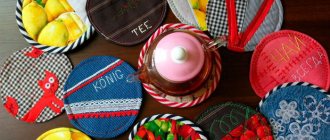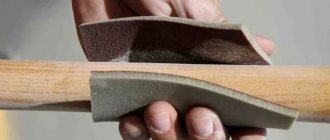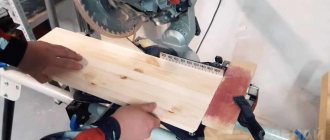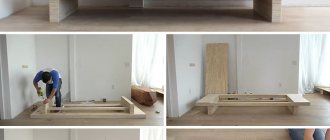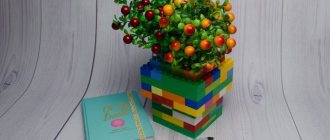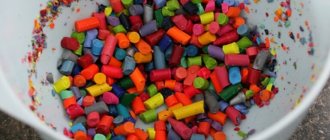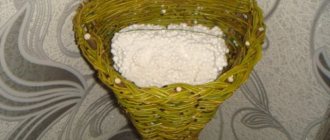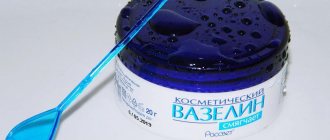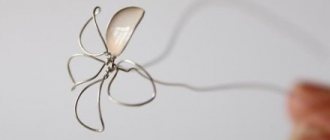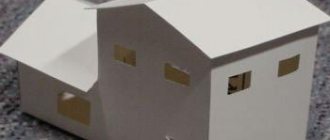Samodelkino
Black varnish for cast iron stoves.
Heat 1 kg of tar almost to a boil and add 50 g of powdered iron sulfate. This varnish, while still hot, is used to cover a heated oven; It dries quickly, is quite beautiful and has no smell.
131. Water-based adhesive varnish.
1 part of wood glue or gelatin is dissolved in 22 parts of water and 28.5 parts of potassium dichromate are added before use. This mixture can serve as a primer for many leather polishes. For better preservation, add a little borax to the varnish.
132. Water-based albumin varnish.
Mix equal parts by weight of water and egg white; For storage, add a little carbolic or salicylic acid. Instead of fresh egg white, you can dissolve 28.5 parts of dry albumin in 564 parts of water. The varnish gives a good gloss when dry. When objects coated with this varnish are dried in hot air, a coating that is indelible with water is formed on them.
133. Water-based gelatin varnish.
Take 1 part of gelatin and dissolve it in 22 parts of water and add 28.5 parts of potassium dichromate before use. This mixture serves as a primer for leather varnishes. For storage, add a little borax.
134. Water-based glaze varnish.
Mix equal parts by weight of water and egg white (or albumin). To prevent albumin from decomposing, add a little formalin or salicylic acid. The varnish gives a good gloss when dry. When objects coated with this varnish are dried in hot air, a coating that is indelible with water is formed on them.
135. Water-based shellac varnish according to Kaiser.
Take 1 part borax, 3 parts crushed white shellac and 20 parts water, heat in a water bath until completely dissolved, after several hours allow to cool and filter. Adding a small amount of glycerin to the varnish makes it flexible. This varnish can be painted with any aniline dye or a mixture of several dyes.
136. Wallpaper varnish.
Dissolve 2 parts borax, 2 parts shellac, 24 parts hot water. So that you can wash the wallpaper with soap and water without damaging the design and paints, they are first coated with this varnish several times. Then, after each application and drying, rub the wallpaper with a soft brush until a shine appears on it.
137. Discoloration of shellac.
In 8000 parts of water, grind 200 parts of chlorine lime and add 1000 parts of shellac in coarse powder. After 24 hours, add a mixture of 1 part concentrated sulfuric acid in 1000 parts water and, finally, 6000 parts boiling water. The completely white shellac floating on the surface of the liquid is removed and the sticks are rolled out of it.
138. Italian varnish.
Italian varnish is known to mean a transparent oil varnish that covers the stringed instruments of Amati, Guarneri, Stradivari and other Italian masters. The recipe for this varnish was lost around 1770. Since that time, violins and all stringed instruments in general have been coated with alcohol varnishes and very rarely with dark brown oil varnishes. In view of this, we consider it useful to provide a recipe for Italian varnish created by the famous Russian violin maker A. Leman. Before making primer, you need to take care of painting the wood. Well-sanded wood is coated with an aqueous solution of brown sepia paint (a liquid extracted from cuttlefish). When the paint, applied with a very moderately wide brush, has dried, the wood is sanded with very fine flint paper and covered with a layer of colorless, quickly drying oil varnish. Then the wood is again sanded with the same fine flint paper, but this time with wood oil, after which it is wiped dry with a clean rag and coated with a colored varnish using a soft round brush, which dries very quickly, so that after a day it is already suitable for sanding with flint paper with oil or water. Colored varnish is made from colorless varnish (it is best to take amber in oil with strong drying), to which well-erased paints are mixed in tubes: brown, red and yellow. To cover a violin, 2 tablespoons of varnish are enough, and no more than 2 coffee beans of paint. The following paints can be used: Indian and Japanese yellow, Robert varnish No. 7, brown varnish, asphalt and speckled varnish. It is best to put colored varnish on a plate. First, paint is released from the tube, thoroughly rubbed with a glass pestle, varnish is added and the varnish and paint are thoroughly mixed. Then, taking a round brush, slowly apply the varnish to the wood. The varnish dries immediately, and therefore you should not brush over one place more than 2-3 times. You need to be careful when making a primer using glue and alcohol varnish, which goes too deep into the wood and greatly affects the sharpness of the sound of the instrument. Quick-drying oil varnish, on the contrary, almost does not penetrate the wood and forms a primer that does not crack or peel like alcohol varnish. After varnishing, the brushes should be immediately rinsed in kerosene and then washed with soapy water. It remains to be noted that coating a significant number of new and old stringed instruments with Italian Leman varnish gave very good results.
About the varnish
Varnish is a cosmetic product that is applied to the nail plates of the hands and feet. In ancient times, women grew their nails long and covered them with a special mixture of herbs and oils to show that they did not do housework. Now the composition of this product includes polymers, solvents, pigments and plasticizers.
Making nail polish at home is quite difficult - to do this you need to know how to work with chemicals correctly
. However, you can prepare a natural-based varnish using henna, alkana or other dyes.
Recipes for preparing various types of varnishes
There are many recipes for varnish products, so you can find a homemade version for various surfaces and purposes. Below we will describe the preparation processes of several of the most popular types.
There are many recipes for varnish products, so you can find a homemade version for various surfaces and purposes.
Five-minute foam
This varnish against moisture and mechanical stress is used for wooden objects. Acetone is poured into the container, then heavily crushed polystyrene foam is added to it; you need to add enough polystyrene foam so that the liquid becomes jelly-like. After dissolving the material, you need to wait a while for the composition to infuse. It is advisable to apply the solution to the surface after 2-3 hours.
After dissolving the material, you need to wait a while for the composition to infuse.
Oil varnish
Manufacturers use expensive drying oils and resins for this type of varnish, and turpentine is added. The composition is not characterized by high strength and durability. You can use flaxseed oil at home. The oil needs to be heated over a fire until bubbles form, then the heat level is set to low so that the oil is heated gradually, the component should simmer gently.
At the same time, you need to melt the East Indian copal in a water bath. The proportion of oil and copal is 100 to 15. Heat the second ingredient until it boils. After this, the heated oil is gradually poured in, but there is no need to turn off the heat from under the oil; mixing of the two substances occurs gradually. Stirring is also done at this time. Then the mixed solution is poured into the oil remaining in the first container.
Take one part of manganese borate, which is added to the total mass; all ingredients need to be cooked for 2 hours. The resulting foam is removed during cooking. You need to create a colorless, thick solution that will flow from the stick in golden threads. The fire is reduced and gradually cools to 60 degrees.
Turpentine is poured into the mixture that has cooled to the desired temperature - 70 parts. It is added gradually with stirring until the solution reaches the desired viscosity.
You can use flaxseed oil at home.
Dammar varnish
This option can be successfully used on light wood species. You need to prepare dammar resin, turpentine, ratio 4/5, white linseed oil is taken in the amount of one quarter.
All elements are boiled together so that all substances dissolve, then filtered; it is better to choose a metal sieve for this. After waiting for 2-3 hours, you can apply the varnish to the surface.
This option can be successfully used on light wood species.
copal varnish
This recipe uses soft light-colored copal - 1 part, turpentine - 2 parts, camphor - 3%. The latter substance is used to improve the elastic properties of varnish. All elements are poured into a bottle, which should be placed next to the heating device. The solution is shaken regularly.
After settling the solution, filter through cotton wool. If the transparency of the composition is not good, then the varnish is heated in a water bath.
This recipe uses soft light-colored copal - 1 part, turpentine - 2 parts, camphor - 3%.
Megilp
This option is also easy to prepare. The following substances are used:
- 12 doses of pure mastic;
- One and a half doses of Venetian turpentine;
- Half a dose of powdered camphor;
- 5 parts crushed glass;
- 30 parts well purified turpentine.
The ingredients are heated and combined together in a water bath, the mixture is allowed to settle, and the solution is filtered through cotton wool.
The ingredients are heated and combined together in a water bath.
Castor varnish
Dry distillation of castor oil produces a mixture similar to rubber. When the mixture is dissolved in gasoline or alcohol liquid, a varnish material is formed that is resistant to water and ultraviolet rays. The recipe is very quick to make.
Dry distillation of castor oil produces a mixture similar to rubber.
Asphalt varnish
One part of asphalt must be mixed with two parts of turpentine. First, the asphalt must be melted, cooled and crushed. Then you can mix both ingredients, resulting in a solution for treating different bases.
One part of asphalt must be mixed with two parts of turpentine.
Japanese varnish
To 45 parts of turpentine add 60 parts of dehydrated lavender oil. Sedimentary elements are removed from the liquid part, and then the solution is heated. At this time, camphor is added to the oil and turpentine - 15 doses. The resulting mass is infused for 15-20 minutes. And then the varnish is filtered to obtain a clean, ready-to-apply varnish on a wooden base.
The resulting mass is infused for 15-20 minutes.
Homemade varnishes help save money, and many of them provide high-quality protection, and the preparation process itself is simple. For this reason, many masters resort to a similar solution. The article described popular recipes for solutions that can easily be used at home. But it is important to remember that the substances included in the recipes are toxic, for this reason they do not forget about safety precautions. It is better to work in a garage or outside.
Varnish based on white clay and henna
You can make natural varnish using olive oil, white clay and henna. If you apply this product several times a week, your nails will look healthy and shiny. To do this you need:
- Mix olive oil and clay in a two to one ratio;
- Add a little henna and stir until smooth;
- Apply the resulting mixture to your fingertips in a thick layer;
- Wait 10-15 minutes;
- Wipe your nails with cotton wool;
- Polish your nails with a piece of silk cloth.
Alkane and beeswax based varnish
Alkane is widely used in cosmetology for the production of creams, masks and soaps. This is a plant whose roots have a coloring and healing effect - you can also make a varnish based on it:
- You need to heat olive oil (3 tbsp) and alkana root (0.5 tbsp) in a water bath;
- Then let the resulting mixture brew for 5 minutes;
- Strain through a fine sieve;
- Place in a steam bath;
- Add beeswax (0.25 tbsp);
- Wait until the wax melts;
- Add 2 drops of vitamin E oil;
- To stir thoroughly;
- Cool the resulting mixture;
- Apply to nails with a special brush in several layers, avoiding contact with the skin of your hands.
Water-based varnish with shadows
You can make your own nail polish with a unique shade using drugstore clear water-based polish and regular eye shadow. To do this you will need:
- Place a blank sheet of paper on the table;
- Choose eye shadow of the same color as the future polish;
- Scrape some shadows onto the paper;
- Crush them into powder with a spoon;
- Pour the shadows into a jar of varnish;
- Using a toothpick, stir the contents;
- Cover your nails with varnish;
- Wait 10-15 minutes.
Wood stain: varieties and their features
The basis for the production of liquid impregnation can be water, alcohol, or oil. And each variety has its own characteristics.
Water stain is available in the form of a water-soluble powder mixture and a ready-to-use mixture. This stain, the second name for stain, is in greatest demand. It can be used for both interior and exterior work.
Powdered stain dissolves well in water. It is environmentally friendly and has elasticity and adhesion. The diverse palette of shades begins with the lightest tone and ends with dark red.
Various shades of stain colors
But there are several disadvantages. First, it is not advisable to use liquid impregnation for resinous rocks. Spots may appear on the surface of the wood. And secondly, by painting a wooden surface with a water-based stain, the wood fibers are raised. The positive thing is that the structure of the wood is more emphasized and at the same time it becomes more susceptible to the influence of moisture.
To eliminate this phenomenon, the surface of the wooden product must be wetted and left for some time. The wood is then sanded and covered with a water-based stain.
Choosing stain color
Alcohol based stain is an aniline dye dissolved in denatured alcohol. It also comes in ready-made and powder form.
The dyes are quickly absorbed into the wood fibers and after half an hour the paint is completely dry.
Uniform painting with stain by hand is unlikely to work, since the alcohol evaporates immediately after application. Thus, stains may appear, so it is better to use a spray gun.
Varieties of stains
Oil stain can color a wooden product in a color known to the human eye. Pigment stain gives wood a uniform color and hides the texture. The impregnating liquid colors the wood from the inside and emphasizes the structure.
Oil-based stain does not dry as quickly as alcohol-based stain, but it is very convenient to work with. It is applied in an even layer and does not lift the fibers, and does not form a film on the surface, which allows the wood to breathe.
Dilute the liquid with white spirit solvent.
Wax and acrylic stains have the same qualities as the tinting materials described above. In addition, wax stain is used to restore the old coating. It paints over small differences in surface color.
These wood stains cover the surface of the wood with a layer that protects it from moisture. It's easy to check. It is enough to pour a small amount of water on the floor, and it will scatter drop by drop. At the same time, the protective film of wax stain is vulnerable to mechanical stress and needs protection. To do this, it is coated with varnish.
Water-based stain in bleached oak color, topped with wax
Acrylic and wax liquids have a rich palette of colors and emphasize the wood texture, which is why they are also called rustic.
Return to content
Varnish bronzer
The secret to creating a cool and beautiful varnish is that a small metal ball (less than a centimeter) is added inside the containers, which will allow you to easily and quickly mix mikka, glitter with colorless varnish.
- Clear varnish
- Golden Mikka
- Bronze Mikka
- Yellow Mikka
- 3 varnish containers
- 3 small metal balls
Step 1
. Place 1 metal ball in the varnish container. This is the most important stage! Without these balls, the mikka will not mix and the polish will end up with lumps.
Step 2
. Now carefully pour the varnish into containers until the hangers begin. we need a place for mickey.
Step 3
. Use small spoons (less than a teaspoon) to add the mickey. 2 spoons of gold and 1 spoon of other types of flowers will be enough.
Step 4
. Now insert the varnish brush, close the varnish tightly and... shake! Until completely mixed.
Now your DIY varnish is ready! It’s very easy to make at home and you can experiment with colors and glitter.
Source
How to make nail polish from eye shadow
The first option includes varnishes at home, which are not so expensive. To do this, you need to pour the required amount of eye shadow into a mixing container, then glitter (if needed) and fill it with colorless varnish. For example, pink polish can be made not only with shadows, but also with small sparkles. After this, so that everything happens quickly enough and the varnish does not have time to begin to thicken, you need to quickly and carefully stir everything until you get a homogeneous mass without various lumps.
This homemade polish can be immediately applied to the nails, and then wait until it dries and carefully touch up the manicure with a toothpick or acetone. If the container is open, such varnish is obtained for one-time use.
But for those who need to make a whole bottle, it is best to take a piece of paper, twist it into a neat tube, the tip of which can easily fit into a bottle of transparent varnish, and add eye shadow, and then mix everything thoroughly with a brush or shake the bottle in hands. It should be remembered that the more shadows you add, the darker the original color will be.
LiveInternetLiveInternet
—Applications
- Cheap flights
Favorable prices, easy search, no commission, 24 hours. Book now - pay later! - Postcards
Reborn catalog of postcards for all occasions - always no analogues at hand
^_^ Allows you to insert a panel with an arbitrary Html code into your profile. You can place banners, counters, etc. there - Online game "Empire"
Transform your small castle into a mighty fortress and become the ruler of the greatest kingdom in the game Goodgame Empire. Build your own empire, expand it and defend it from other players. B - I am a photographer
Plugin for publishing photos in the user's diary. Minimum system requirements: Internet Explorer 6, Fire Fox 1.5, Opera 9.5, Safari 3.1.1 with JavaScript enabled. Maybe it will work
—Links
—Tags
—Categories
- (1)
- LIBRARY (5053)
- AUDIOBOOKS (LISTEN ONLINE) (675)
- VIDEO. (762)
- DOCUMENTARY FILM (465)
- GAMES. (81)
- CINEMA (1190)
- MUSIC. (312)
- DO YOU WANT TO LAUGH? (604)
- PROSE (362)
- POETRY. (720)
- COSTUME JEWELRY (361)
- KNITTED COSTUME JEWELRY (98)
- BEADED COSTUME JEWELRY (159)
- VARIOUS COSTUME JEWELRY (98)
- BEADS. (255)
- BONSAI (23)
- KNITTING with beads (1)
- BEAD EMBROIDERY (50)
- WEAVING (154)
- EVERYTHING AT YOUR HANDS, (329)
- EMBROIDERY (552)
- EMBROIDERY - STAIN STITCH, CROSS, RICHELIEU. (177)
- RIBBON EMBROIDERY (44)
- 3D EMBROIDERY (186)
- EMBROIDERY ON PLASTIC BORDER (27)
- TAPESTRY. (13)
- UTILITIES (81)
- KNITTING (16906)
- Knitting by machine (72)
- CRAZY-WOOL (47)
- TUNISIAN knitting (40)
- KNITTING GENERATORS (14)
- NUKING (13)
- MITTENS. GLOVES (279)
- VIDEO LESSONS (7340)
- KNITTING ON A FORK. (65)
- KNITTING+LEATHER+FUR+FABRIC (160)
- KNITTING IDEAS. (272)
- KNITTED PODIUM. (42)
- KNITTED PATCHWORK. (63)
- JACQUARD (695)
- IRELAND, FREEFORM (1126)
- USEFUL KNITTERS (183)
- RUGS (161)
- SOCKS, STOCKINGS (726)
- REVIEWS ABOUT YARN (61)
- BLANGES (324)
- UTILITIES (2718)
- TABLECLOUTS, napkins (644)
- PATTERNS - HOOK (3500)
- PATTERNS - SPOKES (4341)
- HATS - HOOK (473)
- HATS - KNEWS (660)
- SCARFS, STOPPLATES, SHAWLS (1222)
- KNITTED AND SEWED HATS (303)
- HOUSE AND IN IT (2193)
- MUSHROOMS (48)
- HOUSEKEEPING TIPS (556)
- IDEAS (312)
- UTILITIES (328)
- DIY REPAIR (146)
- GARDEN IN THE APARTMENT (298)
- GARDEN and VEGETABLE VEGETABLE (766)
- WOMEN'S ENCYCLOPEDIA. (2170)
- ABOUT CHILDREN and FOR CHILDREN. (534)
- UTILITIES (1412)
- RULES for WOMEN (67)
- HAIRSTYLES (157)
- KNITTING MAGAZINES (2011)
- Doublet (192)
- Fashion Magazine (139)
- HEALTH (1780)
- TOYS (848)
- AMIGURUMI (143)
- KNITTED TOYS (286)
- MISCELLANEOUS TOYS (236)
- DOLLS (231)
- CULINARY RECIPES. (6678)
- Pancakes, pancakes, casseroles. (248)
- RECIPES for MULTICOOKER (92)
- VIDEO RECIPES (630)
- BAKING (2049)
- PREPARATIONS FOR WINTER (564)
- PORridge (48)
- SAUSAGE (206)
- CANDIES (265)
- CREAM for CAKE (182)
- ICE CREAM (154)
- MEAT, POULTRY, MINTING (850)
- DRINKS (312)
- VEGETABLES, MUSHROOMS and BERRIES (434)
- Dumplings (98)
- PIES, PIZZA, BUNS. (814)
- Utilities (720)
- MISCELLANEOUS (338)
- RECIPES OF LENTEN DISHES (72)
- ROLLS, CAKES, GINGERBREAKERS (240)
- FISH, SEAFOOD (360)
- SALADS (130)
- SWEETS without baking (330)
- SAUCES (102)
- SOUPS (90)
- DOUGH, BREAD, EASTERS. (405)
- CAKES, PASTRY, COOKIES. (698)
- EGGS, Cottage cheese, MILK, cheese. (427)
- JACK OF ALL TRADES. (1613)
- FELTING (52)
- DECOUPAGE (2)
- CARVING (22)
- KINUSAIGA (8)
- LACE (223)
- MOLDING (141)
- MACRAME (19)
- SOAP (28)
- PLASTIC IS IN BUSINESS. (78)
- WEAVING (125)
- PAPER CRAFTS (146)
- BUTTONS (33)
- MISCELLANEOUS (498)
- DRAWING (148)
- CANDLES (17)
- TATTING (20)
- ENCAUSTIC (1)
- FURNITURE (197)
- WOODEN AND CHIPBOARD FURNITURE. (57)
- CARDBOARD FURNITURE, etc. (41)
- FURNITURE IDEAS (105)
- MODELS FOR CHILDREN. (1925)
- MAGAZINES - FASHION FOR CHILDREN (126)
- IDEAS (67)
- SHOES (150)
- KNITTED CLOTHES (956)
- SEWED CLOTHES (204)
- HATS (456)
- MODELS FOR WOMEN. (9827)
- SLEEVELEVESTS, VESTS (556)
- JACKET, JACKET - HOOK (511)
- JACKETS, Sweatshirts - SPOKES (947)
- CARDIGANS (541)
- COSTUMES (209)
- UNDERWEAR, SWIMSUIT (162)
- COAT (276)
- DRESSES - HOOK (771)
- DRESSES - SPOKES (391)
- PONCHO (98)
- PULLOVER, SWEATER - HOOK (563)
- PULLOVER, SWEATER - KNEW (2834)
- THE CUMBS ARE BEAUTIFUL. (99)
- TOP, TUNIC - HOOK (1104)
- TOP, TUNIC - SPOKES (631)
- SHORTS, LEGGINGS, TROUSERS (80)
- SKIRTS (460)
- MODELS FOR MEN. (413)
- WISDOM WILL COME, LIVE! (938)
- ICONS, PRAYERS (111)
- PARABLES, STORIES, POEMS (840)
- TEMPLES (48)
- I DON'T WANT TO BE A TEAPOT. (1651)
- "EDITOR PROGRAM." (100)
- UTILITIES (1065)
- About LI.RU (255)
- PHOTOSHOP (220)
- NEWS (2310)
- CURRENT NEWS. (2294)
- FOOTWEAR (858)
- KNITTED SHOES (141)
- DIY SHOES (116)
- HOME SLIPPERS (612)
- USEFUL TIPS. (807)
- MISCELLANEOUS (400)
- BAGS (295)
- BEAUTY AND EMBODIMENT (29)
- PLASTIC, etc. (14)
- KNITTED BAGS (168)
- SEWED BAGS (86)
- FLOWERS, (390)
- KNITTED FLOWERS (251)
- FLOWERS FROM Nylon and FABRIC (131)
- WHAT IS USEFUL FOR A DIARY. (3640)
- FLASH (234)
- ANIMASHKI (161)
- GENERATORS (417)
- FOR FRAMES useful (230)
- CLIPARTS (387)
- BUTTONS - TRANSITIONS (63)
- HTML CODES (122)
- COMMENTS (51)
- CARDS, PICTURES (158)
- UTILITIES (781)
- SEPARATORS (82)
- FRAMES (673)
- FRAMES “HEALTH” (36)
- FRAMES “helpful tips” (4)
- FRAMES “RELIGION” (35)
- FRAMES without THEME (95)
- Cottage Frames (43)
- CHILDREN'S FRAMES (13)
- VIDEO FRAMES (21)
- FRAMES for POEMS (51)
- WOMEN'S FRAMES (34)
- winter frames (7)
- Witchcraft FRAMES (2)
- COMPUTER FRAMES (9)
- CULINARY FRAMES (137)
- Holiday FRAMES (18)
- HANDMADE FRAMES (35)
- FLORAL FRAMES (52)
- SCHEMES (399)
- BACKGROUND (424)
- SEWING. (2384)
- ALTERATIONS (256)
- PODIUM (56)
- UTILITIES (866)
- chenelle (5)
- WE SEW OURSELVES (1216)
- ESOTERICS. (253)
- Fortune telling and TESTS (45)
- ETIQUETTE. (53)
- THIS IS INTERESTING (4448)
- CAR (38)
- SOCIONICS (12)
- Interesting articles (9)
- ARCHITECTURE (119)
- A CENTURY LIVE - A CENTURY LEARN (156)
- Great Patriotic War (84)
- FOR INFORMATION (1600)
- ANIMALS and BIRDS (474)
- HISTORY (176)
- TRAVELERS CLUB (568)
- THE UNKNOWN (458)
- THE PLANET IS OUR HOME (304)
- Good to know (393)
- GARDENS, FLOWERS, EXOTICS (105)
- SCULPTURES, PICTURES, PHOTOS. (155)
- Yu (81)
- personal (3)
How to make your own wood varnish?
If you urgently need to coat wooden products with varnish, but you don’t have varnish on hand. You can quickly make it yourself. For this you need acetone and polystyrene foam. It is advisable to pour acetone into a transparent container and gradually add crumbled polystyrene foam into it, stirring, when the acetone thickens to the state of ordinary varnish, mix well and you can coat wooden products as with ordinary varnish. The varnish turns out to be quite durable and moisture resistant.
In addition, I can say that the varnish itself is a mixture of a special solvent with various resins. Both natural and synthetic. To independently solve this issue, acetone, as already mentioned, and solvent type 646 and the like are quite suitable. And for the mixture you can use anything that can dissolve in them. In addition to foam plastic, this can be thin cellophane, any cellulose or plexiglass. Only if the material is sufficiently thick will it have to be crushed.
Source
How to make foam glue
Adhesive compositions can be used in a variety of situations, so many are faced with the problem of not having such compositions in the house. One solution is to create glue from polystyrene foam. It is capable of connecting various objects quite firmly, so it can even be used to seal an old roof.
Where can foam adhesive be used?
The glue described is often created when there is no glue in the house or it runs out at the most inopportune moment. This substance can also be used in the event of a sudden crack in the roofing material.
Some owners of houses and apartments use the described glue to fasten interior items. For example, this composition can be used to securely fix a cornice on the ceiling. This will reduce work time. After hardening, the composition reliably holds the connected elements together, so you don’t have to worry about them starting to separate over time.
Often this glue is used when installing materials such as extruded polystyrene foam. It is also usually used when fixing ceiling plinths or gluing furniture.
How to make glue
Creating glue is quite simple:
- First you need to find a solvent and pour it into a small container. The size of the container depends on the amount of glue you are going to receive.
- Solvent must be poured into the container. Many people use gasoline to produce glue from the described material.
- After this, it remains to lower the material into the solvent until a viscous substance is formed in the container.
This composition is suitable for fastening various parts and, after hardening, holds them securely for a long time.
You can use a brush to apply glue. For example, such compositions are often used to coat damaged areas of roofing or joints of roofing material. After hardening, the material dissolved in gasoline resembles glass.
There is another way to create the described adhesive composition. To prepare the substance, some homeowners place crushed foam in the area that needs to be covered with glue. After this, it is wetted with gasoline or another solvent. As a result, the material melts and is evenly distributed over the surface. The composition quickly fills all cracks, thanks to which it reliably seals them.
An example is the work of sealing cracks in roofing material. Often glue is used to fill cracks in slate. It can also be used to seal roofing felt joints.
Before you make glue, you need to make sure that you have prepared a sufficient amount of material. If there is not enough material, the composition will be too liquid and will not be suitable for gluing anything.
Features of the composition
When making glue from foam plastic, it is necessary to follow safety rules and carry out all work away from open flames, since such a mixture not only ignites well, but also burns for a long time.
The glue must be well mixed, because if it is not uniform, the objects being glued may not be securely connected to each other. Foam glue can be used to join various materials.
Some people use similar compositions as a protective coating. But the consistency of such a composition should be more liquid. When creating an adhesive composition from polystyrene foam and gasoline, you must remember that it hardens after a few days. The thicker the applied layer, the longer it takes to dry.
Typically, such glue is used when there is no adhesive on hand or it runs out at the wrong time. Some people use various plastic products instead of foam. For example, table tennis balls or disposable cups. To make it more convenient to work with the material, you need to cut it into small pieces or crumble it in advance.
To make the glue dry faster, you should choose acetone solvents for its preparation. After hardening, the composition is able to withstand both low and high temperatures. That is why they can be used to seal cracks in the roof and not worry about them starting to leak moisture again.
What type of foam can be used to create glue?
Foam plastic is a group of materials that are foamed masses. Most often they are used for thermal insulation of premises. Depending on the production method, they are divided into 3 main types:
- Pressless. Such products look like a lot of interlocking balls. When such products are physically impacted, the balls are easily separated from each other and the product begins to crumble. This type of foam is most often used to create glue. It easily dissolves in gasoline and acetone and turns into a stretchy mass.
- Pressed. This foam is more durable and does not crumble like the previous type. This is explained by the fact that during production the products are pressed.
- Extrusion. This material has a more uniform structure, since during production the temperature of the products increases. The result is foam plastic, which has a solid structure.
You can also use granulated foam to create glue. But before you make glue from the described material, you need to try to dissolve different types of foam in gasoline. Some products melt worse, so you should not prepare only one type of material in advance. It is most convenient to use granular foam.
To make glue from foam plastic without harming your own health, you must carry out the work outdoors or in a room with completely open windows. If this rule is not followed, gasoline vapor poisoning may occur.
Thus, with a small amount of polystyrene foam and solvent it is easy to make a reliable adhesive that can even be used to seal the roof. But in order for the resulting composition to last for a long time, it is important to make it in such a way that it is viscosity and homogeneity.
bouw.ru
